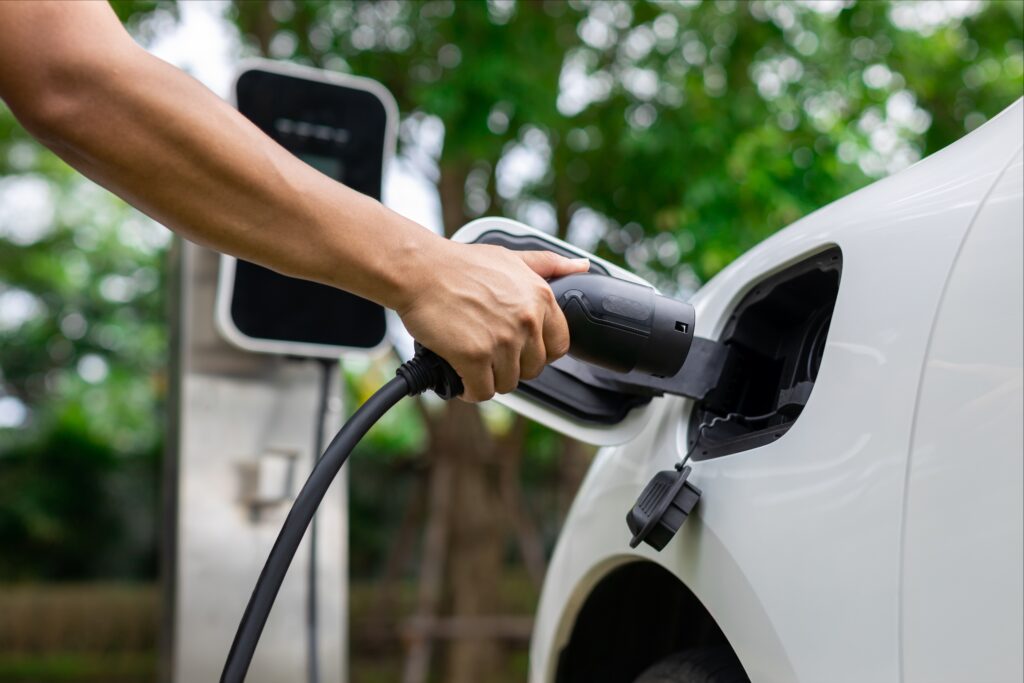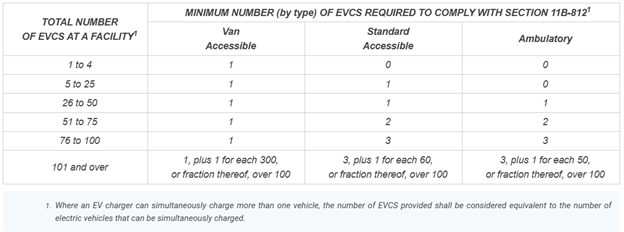
Back in July 2024, CALGreen requirements for Electric Vehicle (EV) charging increased for both residential and non-residential projects. In particular, requirements for multi-family projects and hotel/motel uses increased significantly, leading to more installation of EV charging stations (EVCS) which then triggers compliance with accessibility standards. In one of the many examples of different codes navigating overlapping scope, CALGreen and CBC Chapter 11 both address accessibility for EV charging, with CALGreen generally deferring to CBC while filling in a few gaps. As EV charging is on the rise, let’s review some key points for EV accessibility.
- EV charging in public facilities must meet CBC accessibility requirements. CALGreen directly refers to CBC Chapter 11B for EVCS accessibility requirements for any use listed under CBC Chapter 11B, including Public Buildings, Public Accommodations, Commercial Buildings and Public Housing. CBC Chapter 11B includes Table 11B-228.3.2.1 which specifies how many accessible EVCS stations are required (see below), based on how many total EVCS are installed. In other words, CALGreen dictates the minimum number of EVCS that must be installed, and the building code addresses accessibility requirements from there.

- Parking spaces with EVCS required under 11B do not count for accessible parking. Per CBC Chapter 11B-208.1, accessible EVCS parking spaces must be additive to the minimum number of accessible spaces. There’s an exception for public housing, where an accessible parking space assigned to a residential unit may be an EV parking space.
- EV parking spaces for private multi-family housing is covered under CALGreen. Unlike CBC Chapter 11B, Chapter 11A Housing Accessibility does not directly address accessible EVCS requirements. Therefore, those requirements have been added to CALGreen in Section 4.106.4.2.2.1 Electric vehicle charging stations. The requirements parallel the CBC – 18’x9’ space, 1 in 25 must be accessible, include an aisle for van spaces, serve a path of travel, etc. Chapter 11A still addresses the distribution of accessible spaces in a multi-family housing project and other details which apply to EVCS, so both codes apply.
- If you have any public EV charging equipment, at least one must be van accessible. At the risk of repeating what is spelled out above, a helpful guideline for designers, builders and plan checkers is that any time you have an electric vehicle charging station at a public place or any multi-family housing, at least one of them must be van accessible.
- EV Capable spaces do not trigger access compliance. EV Capable and EV Ready spaces do not have charging equipment, so when there’s no charger, there’s no accessibility requirement. The intent is to make adding EVCS easy in the future, so best to plan ahead for easy addition of signage or potential re-striping.
More details can be found within each code section.
With the use of electric vehicles continuing to ramp up, providing appropriate accommodation for all users is more important than ever. With planning and coordination among design and construction teams, EV charging will simply fold into inclusive project designs.
For more information and in-person trainings, please check out our events calendar at 3c-ren.org/calendar-of-events-and-trainings
The on-demand webinar page is at 3c-ren.org/on-demand-trainings
And feel free to reach out to the Code Coach Hotline for more information or to have your Energy Code or CALGreen questions answered! 3c-ren.org/energy-code-coach
